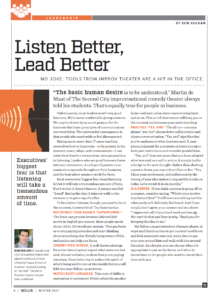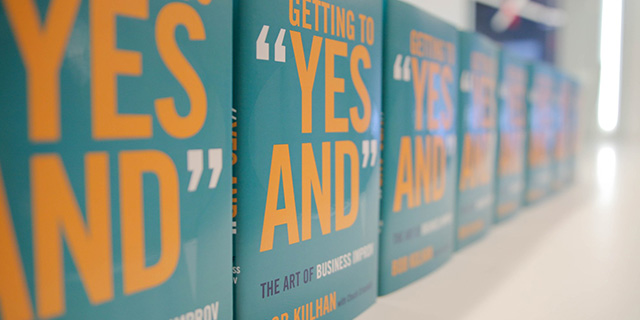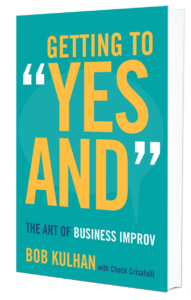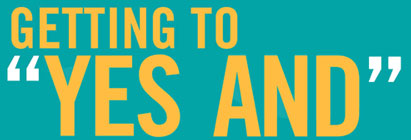Adapted from “Getting to “Yes, And”: The Art of Business Improv” by Bob Kulhan, (Stanford University Press, (c) 2017 Robert Kulhan).
 One of the keys to success in any business lies in the ability to generate a tremendous amount of ideas, because when it comes down to it, almost every organization is, at heart, in the idea business. This is not a revolutionary concept. However, what often is overlooked—or simply misunderstood—is that the generation of great ideas is a numbers game. Businesses ostensibly are always looking for killer ideas that will boost profits and cut costs; ideas that streamline processes and maximize investments; and ideas that will have significant impact in the marketplace. To get to those killers, though, a business may have to cough up a mess of ideas that are ridiculous, budget busting, unusable, or simply awful.
One of the keys to success in any business lies in the ability to generate a tremendous amount of ideas, because when it comes down to it, almost every organization is, at heart, in the idea business. This is not a revolutionary concept. However, what often is overlooked—or simply misunderstood—is that the generation of great ideas is a numbers game. Businesses ostensibly are always looking for killer ideas that will boost profits and cut costs; ideas that streamline processes and maximize investments; and ideas that will have significant impact in the marketplace. To get to those killers, though, a business may have to cough up a mess of ideas that are ridiculous, budget busting, unusable, or simply awful.
A business that runs on the assumption that it will come up with a great idea exactly when it needs one is severely limiting, if not deluding, itself. That business is most likely achieving “greatness” by simply lowering the standard of what counts as great. The fact is, to get to unimpeachably great ideas—sharp, innovative, outright brilliant ones—you have to come up with an ugly pile of horrible ones, too (Osborn, Alex, “Applied Imagination: Principles and Procedures of Creative Problem Solving,” 3rd ed., Creative Education Foundation Press, 1963). By way of analogy, think about the old process of gold panning. As you might remember from elementary school studies of the California Gold Rush, panning is the art of extracting gold from a river by scooping up sediment with a large pan. Panning is a sloppy, difficult process, and it can get results.
 Joined in studio today by Bob Kulhan, founder and CEO of Business Improv, and author of Getting to Yes And: The Art of Business Improv.Learn more about Bob Kulhan’s book here.
Joined in studio today by Bob Kulhan, founder and CEO of Business Improv, and author of Getting to Yes And: The Art of Business Improv.Learn more about Bob Kulhan’s book here.
Discussion guide from today’s conversation with Bob Kulhan:
1. What is improv?
2. And how does improv integrate into our daily business practice?
3. “REACT, ADAPT, and COMMUNICATE.”
4. What is “YES AND” and how does it work?
5. What are the cognitive and social psychology behind this?
6. How does “YES AND” and improv help with creativity and innovation?
7. Improv is a skill. How do we learn and develop stronger improvisational skills?
As an entrepreneur, you have to improvise and adapt quickly to survive and thrive in the face of the unpredictable challenges of the market. But this improvisation a not a comedy, although there are some distinct correlations, in relation to reacting, adapting, and communicating. In business and in comedy, you win most often with “Yes, and …” instead of “Yes, but ….”
I definitely learned a few things about how to improvise effectively in business from a new book, “Getting to ‘Yes And’: The Art of Business Improv,” by Bob Kulhan, who is a master of the art in both comedy and business. Kulhan is a professor at the Duke University School of Business, but was trained in improvisation by some comedy greats, including Tina Fey and Amy Poehler. Read More
by Marty Zwilling, Veteran Start-up Mentor; Executive (for Huffington Post)
![]() As an entrepreneur, you have to improvise and adapt quickly to survive and thrive in the face of the unpredictable challenges of the market. But this improvisation a not a comedy, although there are some distinct correlations, in relation to reacting, adapting, and communicating. In business and in comedy, you win most often with “Yes, and …” instead of “Yes, but ….”
As an entrepreneur, you have to improvise and adapt quickly to survive and thrive in the face of the unpredictable challenges of the market. But this improvisation a not a comedy, although there are some distinct correlations, in relation to reacting, adapting, and communicating. In business and in comedy, you win most often with “Yes, and …” instead of “Yes, but ….”
I definitely learned a few things about how to improvise effectively in business from a new book, “Getting to ‘Yes And’: The Art of Business Improv,” by Bob Kulhan, who is a master of the art in both comedy and business. Kulhan is a professor at the Duke University School of Business, but was trained in improvisation by some comedy greats, including Tina Fey and Amy Poehler.
 Bob Kulhan, veteran improv performer, university professor, CEO, and consultant, shares insights from his book: Getting To Yes And: The Art of Business Improv. Bob shows how improv techniques such as the “Yes, and” approach, divergent and convergent thinking, and focusing on being present can translate into more productive meetings, swifter decisions, stronger collaboration, positive conflict resolution, mindfulness, and more.
Bob Kulhan, veteran improv performer, university professor, CEO, and consultant, shares insights from his book: Getting To Yes And: The Art of Business Improv. Bob shows how improv techniques such as the “Yes, and” approach, divergent and convergent thinking, and focusing on being present can translate into more productive meetings, swifter decisions, stronger collaboration, positive conflict resolution, mindfulness, and more.
By David Slocum (for Forbes)
 2017 is opening with a stack of new and helpful books on technology, transformation, and the human and business challenges faced by creative leaders. Here is a list of 17 recommended titles.
2017 is opening with a stack of new and helpful books on technology, transformation, and the human and business challenges faced by creative leaders. Here is a list of 17 recommended titles.
Getting to ‘Yes And’: The Art of Business Improv
Bob Kulhan with Chuck Crisafulli, Stanford Business Books , January 11
An actor, former teacher at Chicago’s famed Second City troupe, and now an adjunct professor at Duke and Columbia business schools shares insights from comedic improvisation for better business performance. Kulhan’s lively guide to developing listening, focus, energy, engagement, adaptation, and decision-making skills provides leaders fresh ways to drive positive change in today’s fast-paced workplace. Read More
NO JOKE: TOOLS FROM IMPROV THEATER ARE A HIT IN THE OFFICE
BY BOB KULHAN (for Solve Magazine)
 “The basic human desire is to be understood,” Martin de Maat of The Second City improvisational comedy theater always told his students. That’s equally true for people in business.
“The basic human desire is to be understood,” Martin de Maat of The Second City improvisational comedy theater always told his students. That’s equally true for people in business.
Unfortunately, most leaders aren’t very good listeners. We’re more comfortable giving answers. We may be driven by so much passion for the business that basic principles of communication are overridden. The unintended consequence is that people who work with us feel disrespected.
Having spent more than 17 years teaching executives how to improvise—to be present in the moment, react, adapt, and communicate—I can attest that there’s a tremendous value proposition to listening. Leaders who are good listeners foster intrinsic motivation. A culture of positive communication spreads throughout their business, and the best talent wants to work for them. Read More

 Today’s episode is with Bob Kulhan who joined us in episode 55 to discuss the transformative power of improvisation in business and life. He’s back today to discuss his new book: Getting to “Yes And”: The Art of Business Improv.
Today’s episode is with Bob Kulhan who joined us in episode 55 to discuss the transformative power of improvisation in business and life. He’s back today to discuss his new book: Getting to “Yes And”: The Art of Business Improv.
For more than three years, he has dedicated incredible amounts of time and energy writing on Getting to “Yes And”: The Art of Business Improv (Stanford University Press).
Getting to “Yes And” is the definitive guide to business improv. Bob teaches readers to think on their feet and approach the most typical business challenges with fresh eyes and openness. He shows how improv techniques such as the “Yes, and” approach, divergent and convergent thinking, and focusing on being present can translate into more productive meetings, swifter decisions, stronger collaboration, positive conflict resolution, mindfulness, and more.
Getting To “Yes And” was created to help everyone improve their business performance and everyday life. As a prescriptive book, it moves past general philosophy and delves into the “how” improv techniques can be easily and thoughtfully applied to various real-world settings. Read More

Amidst the deluge of advice for businesspeople, there lies an overlooked tool, a key to thriving in today’s fast-paced, unpredictable environment: improvisation. In Getting to “Yes And” veteran improv performer, university professor, CEO, and consultant Bob Kulhan unpacks a form of mental agility with powers far beyond the entertainment value of comedy troupes.
The following is an excerpt from Getting to “Yes And” The Art of Business Improv
MYTH ONE: IMPROVISATION IS COMEDY
Improvisation is in fact not comedy. Nor is it simply an approach to acting. Those are two specific types of improvisation, unique to the context in which the improvisation is taking place. There are many more contexts for improvisation, though. Improvisation is a key element of busy emergency rooms; it takes place on NBA basketball courts; it’s a part of the skill set for every policeman cruising the streets—all contexts in which comedy is certainly not intended to be part of the picture. The context dictates the style of improvisation required. The improvisation an emergency room doctor uses in performing a lifesaving operation is unique to that situation, and the kind of improvisation a starting point guard employs in facing an unexpected defensive strategy only makes sense on the basketball court.
A fantastic example of high-level improvisation took place in 2011 when a team of highly trained U.S. Navy SEALs undertook Operation Neptune Spear—the deadly raid on Osama bin Laden’s compound in Pakistan. This mission had been meticulously planned; the SEALs trained for it over months and several contingency plans were developed and put into place. Still, when one of the navy’s Black Hawk helicopters crashed within the compound, a very specific kind of improvisation was required if the mission was to succeed under shifting circumstances. In this case improvisation had everything to do with adapting to changes within a strategy to achieve real, tangible outcomes.
I certainly concede that the most common understanding of improvisation is as a form of comedy. Curb Your Enthusiasm, the aforementioned Whose Line Is It Anyway? and the films by Christopher Guest all showcase amazing comedic work that is based on improv. On a personal level I’ve been incredibly fortunate to spend an enormous part of my professional life on the great Chicago stages of The Second City, the Annoyance Theatre, and iO (where I was coached by Tina Fey and Amy Poehler and performed alongside such notable folks as Jack McBrayer, Ike Barinholtz, Thomas Middleditch, Jordan Klepper, Jason Sudeikis, and Seth Meyers along with many other famous and less famous, equally brilliant comedic improvisers). In that context we were performing with the focused purpose of delivering comedy. The payoff we were after was audience laughter and a great show. Laughter is not the payoff a surgeon, a jazz musician, or a SEAL team is after, though, and it’s certainly not the payoff a businessperson is looking for either. If you’re in front of the board of directors after a dip in fourth-quarter sales and you get thrown a hardball question, the challenge is not to quickly come up with a way you can use your necktie as a comedic prop to make the board laugh (lest that necktie become a noose with which you strangle your career). Instead you must react and adapt to the circumstances and communicate in an engaging and inspiring way.
The takeaway here: improvisation as it applies to the business world is a specific type that works in the business context. The heart of this book is to explicitly demonstrate how the art of improvisation can be used as a serious means of getting serious results.
Excerpted from Getting to “Yes And” The Art of Business Improv (Stanford Business Books, 2017)
 Available Now
Available Now
The Art of Business Improv
Amidst the deluge of advice for businesspeople, there lies an overlooked tool, a key to thriving in today’s fast-paced, unpredictable environment: improvisation. In Getting to “Yes And” veteran improv performer, university professor, CEO, and consultant Bob Kulhan unpacks a form of mental agility with powers far beyond the entertainment value of comedy troupes.


